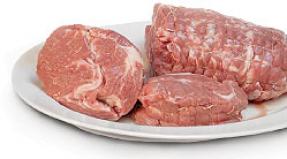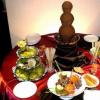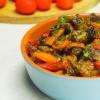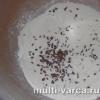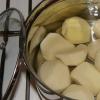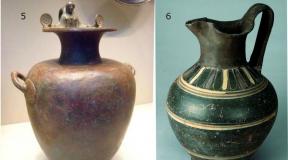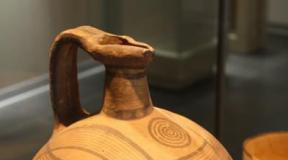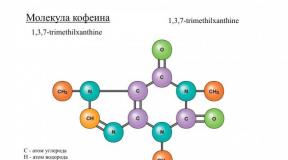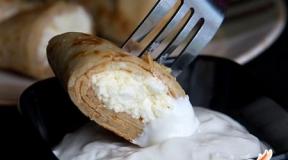How to make a bunk cake from ready-made cakes. Strengthening the tiered cake
To prepare the white biscuit for the first tier: separate the yolks from the whites.
Beat the whites with a mixer until fluffy. Then add sugar gradually, without stopping whisking for 5 minutes. The mass will turn white and increase in volume.
Then add the yolks, one at a time, while whisking. The mass should become homogeneous and very airy.
Pour in liquid mass into flour and mix gently with a silicone spatula. The dough should be smooth and fluffy.
Slightly grease the form vegetable oil... Put the dough into a mold. Place in a preheated oven and bake at 200 degrees for about 35 minutes. Willingness to check with a dry toothpick. It is better not to open the oven door for the first 20 minutes, otherwise the biscuit may fall off. Cool the finished biscuit slightly in the form, and then cool completely on the wire rack.
Then cook chocolate biscuit for the second tier of the cake. Sift flour with cocoa. Separate the whites from the yolks. Beat the whites into a foam, then gradually add sugar and beat for 5 minutes. Then add the yolks one at a time and beat again until smooth.
Pour the liquid mass into the flour and mix gently with a silicone spatula until smooth.
Lightly grease the form with vegetable oil, put the dough in the form and smooth. Place the dough pan in a preheated oven and bake at 200 degrees for about 25-30 minutes. Willingness to check with a dry toothpick. Cool the finished cake slightly in the mold, and then cool completely on the wire rack.
When the cake layers are completely cool, cut each cake layer in half. Soak the cakes with any syrup (I added liqueur to 500 ml of coffee, mixed well and soaked the cakes).
Prepare the cream for our homemade bunk cake: combine cream cheese with icing sugar and mix with a mixer. You don't need to beat for a long time, we just need to combine cream cheese and powder into a homogeneous mass.
Cool the cream well, then beat until firm peaks. I use vegetable oil cream.
Add cream cheese to the cream and stir on low speed until smooth.
To assemble a two-tiered cake: put the cake on a flat plate or stand and brush it with cream.
Put the second cake on top of the cream and press down slightly. Grease the sides of the cakes with cream.
Grease the middle of the white cake with cream and lay on top chocolate cake... Grease the cake well with cream.
Place the second chocolate crust and press down lightly. Coat the top and sides of the cake with cream. In this form, put the cake in the refrigerator overnight.
Decorate the homemade bunk cake as desired. I surrounded the sides of the cake with a chocolate rim. To do this, melt the chocolate in a water bath. From parchment paper cut strips, determine the width and height of the side by your cake. Place the chocolate on the parchment and place it on the sides of the cake. Put the cake in the refrigerator for 10-15 minutes to freeze the chocolate. And then carefully remove the parchment. I made the sides of chocolate just above the cakes, and put them in the resulting niches fresh berries... Here's a cake turned out. Unfortunately, there is no cutaway piece, as on festive table they ate the whole cake at once, leaving not a single slice for the morning.
Enjoy your tea!
For those who are not afraid of difficulties and like to spend time in the kitchen, we suggest preparing an elegant and interesting two-tier cake with their own hands in the form winter hut... The dessert consists of standard biscuits: bottom with creamy sour cream and peanuts, top with delicate and pleasant cherry mousse. Ready product covered with protein cream and decorated in accordance with the New Year theme.
For convenience, we recommend to divide the formation of the cake into several days, for example, bake biscuits in advance, and only then engage in the "assembly" of tiers and decoration. The cake, of course, is not the fastest to prepare, but the result is worth the effort! Guests from your culinary excellence they will be completely delighted, and how the children will be delighted with such a sweet surprise! Let's create together winter's tale do it yourself!
Ingredients: 
Bottom biscuit (shape 26 cm):
- eggs - 8 pcs.;
- sugar - 240 g;
- flour - 160 g;
- starch - 50 g;
- butter- 50 g;
- baking powder - 1.5 tsp;
- vanilla sugar - 2 tsp.
Upper biscuit (form 16 cm):
- eggs - 2 pcs.;
- sugar - 60 g;
- flour - 40 g;
- starch - 10 g;
- butter - 10 g;
- baking powder - ½ tsp;
- vanilla sugar - 1 tsp.
Impregnation for biscuits:
- sugar - 90 g;
- water (boiling water) - 300 ml;
- cognac - 1-2 tbsp. spoons.
Lower biscuit cream:
- sour cream 20% - 200 g;
- whipping cream 33-35% - 200 ml;
- sugar - 120 g;
- peanuts - 100 g.
Top biscuit mousse:
- cream 33-35% - 150 ml;
- frozen cherries - 150 g;
- cream cheese- 130 g;
- sugar - 80 g;
- powder gelatin - 5 g;
- water (to dissolve gelatin) - 30 ml.
- egg whites - 4 pcs.;
- sugar - 200 g;
- vanillin - a pinch;
- butter - 320 g.
Protein cream for decoration:
- egg whites - 3 pcs.;
- water - 75 g;
- sugar - 150 g;
- salt - a pinch;
- lemon acid- a pinch.
Registration:
For windows:
- dark chocolate - 40 g;
- butter - 10 g;
- marmalade;
- sweet straws.
For Christmas trees:
- waffle cones for ice cream - 2 pcs.;
- butter - 100 g;
- condensed milk - 4 tbsp. spoons;
- food coloring (green).
DIY bunk cake recipe with photo
How to make a biscuit for a bunk cake
- Cooking the bottom biscuit. We separate the proteins very carefully from egg yolks, place in a deep, clean and dry bowl. Beat with a mixer, gradually adding half of the sugar. We work until "strong peaks" are obtained (that is, until a dense mass is obtained, which remains motionless when the bowl is tilted / overturned).

- Separately together with the second part granulated sugar and fragrant vanilla sugar beat the yolks. We work with a mixer for at least 5 minutes. The mass should lighten, thicken noticeably and increase by 2-3 times.

- Gradually mix the yolks into the whites with gentle movements from bottom to top. Flour, combined with starch and baking powder, sift in parts on egg mixture, stirring carefully each time. Our task is not to upset the lush mass, so we work very carefully! Stir the tender in a circle biscuit dough it is impossible, only from the bottom up!

- Melt the butter, cool and pour over a homogeneous dough along the edge of the bowl. Stir for a short time.

- The bottom of the mold with a diameter of 26 cm is laid with a circle of parchment, the walls are not greased. We fill the container with biscuit dough and send it to the preheated oven. We bake at 180 degrees until "dry match".

- Turn the mold with freshly baked biscuit and put it on two bowls or on a wire rack. Leave the baked goods in this form until they cool completely. This step will help prevent the top of the biscuit from settling.

- We prepare the upper biscuit in the same way as the lower one, only this time we take a form with a diameter of 16 cm.

How to make mousse for the top tier
- As a filling for the top biscuit, prepare cherry mousse... To do this, fill the cherries with sugar without preliminary defrosting, put on slow fire... While stirring, heat for about 5 minutes (until the sugar is completely dissolved and the berries soften).

- Cool the cherry mass, and then turn it into a “puree” using a blender. Rub thoroughly through a fine sieve. We will use all the resulting juice to make mousse ( small pieces we do not use the cherries remaining on the sieve).

- Whip cold cream until firm. Add cream cheese room temperature and Cherry juice... Stir until a homogeneous, evenly colored mass is obtained.

- Remove the upper biscuit from the mold (we first pass it along the sides of the container with a knife). Cut the pastry into two cakes. We wash the form, wipe it dry, lay the bottom and walls with parchment. We put it in a prepared container bottom cake, pour with impregnation (for its preparation, dissolve sugar in boiling water, cool, add brandy).

- Pour gelatin with cold, pre-boiled water. Let the mass swell.

- We place a bowl with swollen gelatin in a bowl with hot water... Stir constantly until the powder dissolves.

- We introduce the gelatinous solution into the creamy cherry cream with continuous whipping with a mixer. We spread the mass on the bottom cake, level it. We remove the container in the refrigerator until the mousse hardens.

How to make cream for the lower tier
- While the mousse is solidifying, prepare the bottom tier of the cake. Beat the cream with sugar until thick. Add sour cream, beat for a few seconds (until the components are combined into a single cream).

- Fry peanuts in a dry frying pan, stirring occasionally. As soon as the skin begins to crack, remove from heat and cool. After removing the husk, grind the peanuts with a blender.

- Divide the biscuit into 3 cakes. Water the bottom with impregnation, and then grease with half of the creamy sour cream... Distribute half of the peanuts on top.

- Cover the base of the cake with the second crust, soak it, apply the rest of the cream. Sprinkle with the other half of the peanuts. Pour the last cake with impregnation and spread it on top. We do not coat the top and sides of the workpiece with anything yet.

- Soak the second cake for the upper biscuit and put it on the frozen mousse. We put both the upper and lower tier for the cake in the refrigerator.

How to Make Butter Protein Cream For Cake Topping
- Mix the proteins with sugar, place the bowl on " water bath". Actively and continuously stir the mixture with a whisk, heat the mass over low heat until the sugar dissolves. To test the doneness, take a small portion of the protein and rub it between your thumb and forefinger. If grains are not felt, remove the container from the stove. It is important not to overheat the proteins, otherwise they may curl up! The bottom of the protein bowl should not touch the water in the lower bowl.

- Add vanillin to the proteins just removed from the heat for flavor and immediately begin to beat the mass. Gradually, the proteins will thicken. We work with a mixer until “soft peaks” are formed. It is not necessary to achieve a very strong and stable mass, as in the manufacture of a biscuit. As soon as clear streaks from the mixer remain on the cream, we stop.

- We load the softened butter in small pieces to the protein mass, constantly working with a mixer. As a result, we get a fairly dense oil cream.

- We take out the bottom blank from the refrigerator. We coat the top and sides with butter and protein cream, align.

- To prevent the lower tier from sinking under the weight of the upper one, we strengthen our "structure". We take wooden skewers, cut them to the height of the lower tier and stick them into the biscuit in the place where the upper tier will be located (according to our idea, it will stand on the edge of the lower biscuit).

- Place the top tier on a cake base that matches the diameter. We coat with butter cream, level. Together with the substrate, we place it on the prepared lower tier.

How to make a bunk cake with your own hands
- To make our cake look like a hut, cut out and remove the triangular segment from the lower tier. Apply butter cream to the cut, and then attach a straw to simulate wooden planks. The upper tier is also slightly trimmed, greased with cream and supplemented with straws.

- For making "windows" on sprinkled with sugar kitchen board roll out the marmalade. We cut out square blanks of suitable size. Sugar is needed to keep the pieces of marmalade from sticking to the work surface.

- Melt the chocolate with butter in a "water bath", cool it and put it in a cornet. Apply a small portion chocolate mass on straws and pieces of marmalade, attach the "windows" to the "house". We also outline the contour of the "windows" with chocolate.

How to make a protein cream for a bunk cake
- To make our two-tiered cake look even more like a snow-covered hut, cover it with protein cream. Boil the syrup - pour the sugar with water, bring to a boil. We heat the syrup to 118 degrees.

- At the same time, beat the whites with citric acid and a pinch of salt until strong peaks (when turning the bowl, the whites must firmly "sit" in place).

- Without stopping to work with a mixer, pour hot syrup into the protein mass in a thin stream. Whisk the cream continuously until it cools down to room temperature (about 10 minutes).

How to decorate a bunk cake with your own hands
- We coat the tiers of the cake with snow-white protein cream, make vortices around the "windows" to imitate icicles.

- Decorate the cake with figurines if you wish. To make a snowman, we sculpt 2-3 balls from marmalade different sizes, placed on the free edge of the lower tier. We coat the figure with protein cream. We form the "carrot", "hat" and "buttons" again from marmalade, draw "eyes" with chocolate, "hands" we make from pieces of straw. We prepare "Christmas trees" from horns and butter cream with dye ( detailed technology described in the recipe
Table decoration is definitely a cake. At the same time, a three-tiered one looks like a real king of a feast, whether it is a celebration of a wedding, birthday, anniversary or any other date.
Even the most eminent pastry chefs in the world consider such baking to be the pinnacle. culinary arts... What can I say, a three-tiered cake is not an easy job. But believe me, he is within the power of "mere mortals". The main thing is to be patient, set a goal to do everything neatly and learn a couple of tricks. Here we will talk about them.
Someone else's mistakes are the best teaching material
If you think that for cooking three-tiered cake it is enough to stack three cakes of different diameters on top of each other in descending order, then rather give up this venture! Otherwise, just waste time and transfer products. You shouldn't act at random.
What happens if you don't follow the technology? The most common side effect- deformation of the lower cake, which could not withstand the pressure of the upper ones. It can simply fall apart or swim to one side. Due to deformation, the upper cakes will warp, and possibly even collapse. Effective, isn't it? To avoid such embarrassment in the middle of a banquet, it is worth paying attention to theory.
A method of forming a three-tiered cake with your own hands
How to avoid frustration of plans, cakes and hopes? Let's use a trick that will strengthen the structure. And for her we need bamboo skewers and cocktail tubes.

Find the center of each cake, mark it. At the second end, measure the radius and set aside the same distance from the center of the bottom cake. We do the markup and carefully place the second tier on the first. The markings will help to avoid skewing. Using the same principle, we put the top cake on our cake.
Working with squares is even easier. And cakes of an unusual shape (hearts, for example) are also unlikely to cause difficulties for those who understand the very principle of how to make a three-tiered cake.
Now comes the fun part. In the center of the cake we make a puncture with a skewer, we pierce all three cakes. Stir the hole a little so that the tube will fit into it. We insert the tube, pour melted chocolate inside (it is convenient to do this from a syringe), immerse a skewer into it. In the same way, we make several more bearing axes around the middle one. They will prevent the cake from collapsing to one side.
It is logical to assume that the lighter the middle and upper tiers are, the less stability problems there will be. Choose a "heavier" dough for the bottom crust. For example, you can take brownie as a basis - very tasty and beautiful recipe... Not bad for a base and a recipe for honey cakes.

Ideal for the second and third tiers light biscuit or puff pastry like Napoleon. Lungs coconut cakes"Rafaello" also will not weigh down the structure and will add unforgettable notes to the taste.
Making soufflé and jelly
In general, the top of the cake can be made not from dough, but from soufflé. Any dessert recipe will work. Whisk 10 chilled whites, adding sugar in stages (1 tbsp). At the very end, add 0.5 tsp. citric acid. Next, dissolve 10 g of gelatin in 100 ml of water. When the gelatin swells, pour the mass in a thin stream into the whites, stir with a spoon and put in a mold. The soufflé will freeze for at least 12 hours.
A jelly tier would also be an excellent option. To prepare it, add 1/3 less to soluble water than the manufacturer recommends.
Cake cream
Before you start, consider what your three-tiered cake will look like. Perhaps it is worth tightening the cakes in the mastic before the pyramid begins to gather? Or maybe no mastic is planned at all and you will be pleased to grease a ready-made cake with cream?

Try to make layers of cream between the tiers. Yes, and the cakes themselves can be divided in advance along and well soaked with them.
Avoid overly liquid creams. If you are at a loss with the choice, prepare a win-win: Heat 200 grams of butter to room temperature, beat at low speed until fluffy, add 250 g of boiled condensed milk, whisking. Before starting work, keep the cream in the refrigerator for at least 20 minutes.
Such a cream not only does not flow, but also keeps its shape perfectly. And also, thanks to the viscous consistency of condensed milk, it glues the cakes together, providing additional strength.
Excipients, fillers, decor
Afraid that your three-tiered cake isn't strong enough? Use another trick. Dilute the cool berry jelly by adding no more than a third of the recommended volume of water to the pack. Spread the cakes as if with glue and join together.
Unleash your imagination if you are preparing three-tiered children's cakes. Photos show that they can be decorated in the form of a fairytale castle or decorated with characters from your favorite children's fairy tales.


Alternative ways: unusual dishes
If you really want to cook a stunning dessert, but you are afraid that the task will be overwhelming, use the simpler method. Who said that a three-tiered cake must be monolithic? Place the cakes on the tiers of a special serving dish as shown in the photo.

Such a dessert will look no less impressive, especially if you arrange baked goods in the same style.
Preparation delicious cake- a responsible task for every housewife. And if the cake is baked for the holiday, it still needs to be given beautiful design... Prepare a beautiful two-tiered cake for the celebration, decorated with mastic and roses from it. This one will surely conquer all the guests gathered.

Ingredients:
For the upper tier (honey cake with prunes and sour cream):
- flour - 3 glasses;
- egg - 2 pcs.;
- sugar - 1 glass;
- honey - 2 tbsp. spoons;
- butter (can be replaced with margarine) - 100 gr.;
- soda - 2 tsp;
- vinegar - for extinguishing soda.
For the cream:
- sour cream (15-20% fat) - 400 gr.;
- sugar - ½ cup.
For filling:
- prunes - 250 gr.

For the bottom tier (chocolate biscuit with cherries and butter cream):
The ingredients are indicated for one biscuit (you need two biscuits for the cake to give the cake the required height).
- flour - 80 gr.;
- egg - 4 pcs.;
- sugar - 150 gr.;
- baking powder - 1 tsp;
- cocoa - 2 tbsp. spoons.
For the cream:
- whipping cream - 1 glass;
- icing sugar - 1/2 cup.
For filling:
- cherries (fresh or frozen) - 500 gr.;
- sugar - 3 tbsp. spoons.
Common ingredients for the two cakes:
To line up cakes:
- butter - 400 gr.;
- condensed milk - ½ cans.
For mastic:
To cover the cake:
- marshmallows ( white) - 300 gr.;
- icing sugar - ~ 1.5 cups;
- butter - 1 tbsp. a spoon.
- marshmallows - 400 gr.;
- icing sugar - ~ 2 glasses;
- butter - 1 1/4 tbsp. spoons;
- food coloring Pink colour- on the tip of a knife.
For leaves:
- marshmallows –100 gr .;
- icing sugar - ~ 0.5 cups;
- butter - 1 tsp;
- food-grade green dye - on the tip of the knife.
The diameter of the top tier of the cake is 15 cm, the bottom tier is 22 cm.
How to cook from a photo step by step
Let's start preparing our two-tier cake with mastic precisely with the preparation of roses, as they must dry out a little before placing on the cake. 
So, take the marshmallows, separate them by color. Leave the white marshmallows to cover the cake, and use the pink ones to make roses. Place the pink marshmallows in a container, add oil to them. 
Place the container with the listed ingredients in the microwave and heat them at 600 W for 1 minute until the marshmallows expand in volume. Stir everything with a spoon. 
Add food coloring pink (you can also any other of your choice). We use the dye to give a bright color to the roses. Stir everything again until the color is uniform. 
Add powdered sugar in small portions and knead until you get a homogeneous plastic mass - mastic. 
Roll it on a table sprinkled with powdered sugar with a rolling pin into the layer.
We will use two types of roses in our bunk cake. We will make one type of roses using cuttings.
So, with the help of special cuttings "Rose" cut out blanks of different sizes. 
Thinner a little with the special flower edge tool. 
Make a cone from a small piece of mastic and stick it onto a toothpick. This will be the base of the rose. 
Pass the smallest diameter workpiece onto a toothpick and attach it to the cone using a drop of water. 
Now also, using a drop of water, glue one petal to the cone (wrap it around it). 
Next, glue the opposite petal to the already glued petal. 
Then, in the same way, glue all the other petals. 
In the same way, thread the next workpiece and glue it with a drop of water. Also, glue all the petals to the previous workpiece. 
Next, glue the next blank. 
And - the last one. Leave the rose to dry. 
Do it this way required amount roses.
To make the second type of roses for a cake with mastic, cut out two circles of a smaller diameter (I have 4 cm) and five circles of a larger diameter (I have 5.5 cm). These will be rose petals.
Thin the edges of the petals. 
Make a rose cone and stick it onto a toothpick. 
Glue one petal to the cone with a drop of water and wrap it around it, leaving a little free edge. 
Then place another petal on the free edge of the petal and also wrap around the previous petal. Glue each petal to the previous one with a drop of water. 
Next is the next petal. In this way, glue all the petals. Dry the roses. 
Prepare green mastic. Roll out and use a special cut to cut the leaves. 
Also flagella can be made from green mastic. You need to roll the mastic into thin strips and wrap them around the pencil. 
Cooking a honey cake.
Combine eggs with sugar. Beat them with a mixer or grind with a whisk.
Add softened butter and honey.
Quench the baking soda with vinegar and also add to the ingredients.
Stir everything. Now you need to make a "water bath". Boil water in a saucepan. Place the container with the mixed ingredients on top of the pan (the water in the pan should not reach the bottom of the upper container). Keep the container in the bath for 15 minutes. During this time, the mass in it should increase. Remove the container from the bath and add flour.

Separate small pieces from the dough. 
Roll them out with a rolling pin. Cover with a plate (lid or mold) of the correct diameter and cut off any excess dough. 
Transfer the dough to a floured baking sheet. 
Bake in an oven preheated to 180⁰C until golden brown for about 10-15 minutes.
Cool the finished cakes.
To make honey cake cream, combine sour cream with sugar.
Beat with a whisk until the sugar is completely dissolved.
Pour prunes with hot water and leave for half an hour to swell. Then dry it and cut into small pieces.
Collect the bunk cake. On the flat dish put the cake down. Lubricate it with cream, not reaching the edges of about 1 cm (this is necessary in order to exclude further contact of the cream with the mastic).
Sprinkle with prunes on top. 
Cover with a second crust and follow the same procedure. In this way, collect the whole cake. Leave it on for at least a few hours to soak.
By the way, instead of sour cream, you can use condensed milk, as in ours.

Cooking a chocolate sponge cake.
This cake uses two biscuits.
Divide the eggs into whites and yolks.
Add half the sugar to the yolks. Beat the yolks with sugar with a mixer until the mass is lightened.
Beat egg whites separately until soft peaks. After that, while continuing to beat, gradually add the remaining sugar. Whisk the whites and sugar until stiff peaks (shouldn't spill out of the bowl when turning the bowl upside down).
Add a third of the whipped whites to the yolks. Stir the mass. Sift flour mixed with baking powder and cocoa to it. Stir with a spatula, lifting the mass from bottom to top.
Add the remaining proteins. Mix everything gently again. 
Grease a detachable baking dish with butter and cover with parchment. Transfer the dough into it and smooth the surface. 
Bake the sponge cake for about 30-35 minutes at 180 ° C in a preheated oven. Do not open the oven for the first 20 minutes, otherwise the biscuit will fall off. After the biscuit is baked, leave it in the oven for about 1 hour. Then remove and cool on a wire rack.
The biscuit should rest for at least 5-6 hours. Then cut it lengthwise into 3 cakes. Since we have 2 biscuits, we get only 6 cakes (I did not use one cake, as the cake was too tall). You can use all cakes. 
Combine the cherries with sugar to make the chocolate sponge cake soak.
Put on fire and boil them for 5 minutes. Cool it down. Strain them through a colander.
Saturate with expressed juice biscuit cakes... Place some of the cherries on the soaked crust. 
Whisk the cream and powdered sugar to make the cake cream.
Then brush the crust with cream.
Cover with a second crust, add cherries and brush with cream.
Collect the whole cake. Leave it on for a few hours to soak. 
Beat the softened butter with a mixer.
Then add the condensed milk and continue whisking until you have a fluffy cream. 
Cover both cakes with cream on the top and sides, smoothing out any irregularities on the cake. The surface for the mastic should be as even as possible, because the mastic does not hide, but, on the contrary, shows all the irregularities. 
Put the cakes in the refrigerator for a few hours so that the cream hardens well. The top can be reapplied with a layer of buttercream if necessary. The cured butter cream can be further leveled with a knife. To do this, warm up the knife in hot water and wipe it dry. 
Prepare white mastic, roll it out and use a rolling pin to transfer it to one tier. Smooth well, cut off excess. 
Do the same with the second tier.
Now collect the cake. Since the upper tier of the cake is heavier than the lower one, the cake can be additionally strengthened with wooden skewers. To do this, cut the required length of the skewers, equal to the height of the lower tier, and stick them into the lower tier. (If you have a light top tier, for example sponge cake, then you do not need to stick the skewers). 
Set the top one on top of the lower tier. Close the gap between the tiers with a tourniquet. 
Decorate the fondant bunk cake with roses, leaves and flagella. 
And also for lovers of mastic jewelry we offer to look
Surely many housewives admire beautiful multi-tiered cakes, and are wondering how to make a bunk cake at home? For some, it seems like magic and a work of art, and they are even afraid to try. But, it is not at all as difficult as it seems if you know how to cook ordinary cake layers and cream.
Of course, there are some secrets in making two-tiered cakes, but they are not so much about the culinary skills as the secrets of cake-making. Often, due to improper assembly, cakes can skew, fall through, or even collapse on their side. All this can be avoided if you use simple techniques that are used by experienced pastry chefs.
Most often, pastry chefs use two types of cakes to make two-tiered cakes. The bottom cake is baked from shortcrust pastry, and the top is biscuit. If the bottom cake is biscuit, then the top must be lightened and made from a light soufflé. However, it happens that you need a cake with both biscuit tiers, in which case, the cake needs to be strengthened. How to make a bunk cake at home from biscuit dough, let's take a closer look.
DIY bunk cake, recipe with photo
Bunk cake with your own hands, you can cook from ready-made biscuits, or bake them with your own hands. Of course, this requires molds of different diameters, and a lot of time. It is better to prepare the biscuit dough separately for the lower tier and separately for the upper tier, so as not to confuse. After all, a biscuit rises strongly during baking, and you do not need to pour the dough into one form.
Biscuit dough for the bottom crust:
Bottom biscuit (shape 26 cm)
Upper biscuit (form 16 cm)
Cooking a bunk cake with your own hands
The recipe for making biscuit dough is the same for the top and bottom cakes.
Separate the whites from the yolks very carefully in different containers.
Begin to beat with whites, from the smallest revolutions. Add sugar gradually (half the total), and gradually increase the speed. The whites should be whipped in strong foam and do not spill out when the bowl is turned over.
Now you can beat the yolks with the remaining sugar and vanilla. When the yolk mass significantly increases in volume and turns white, very carefully pour the yolks to the whites, and mix with a mixer whisk, but do not turn on the mixer itself.
Combine the flour with baking powder and gradually add it to the egg mixture, being careful not to sediment the foam.
When the flour is completely mixed with the egg mass and the dough is smooth, melt the butter and add it to the dough.
The biscuit dough is ready, and you can start baking the cakes.
Baking cake layers
Place a circle of parchment paper on the bottom of the mold, according to the diameter of the bottom. Pour the dough into a mold and place it in an oven preheated to 180 degrees.
Look at the biscuit. When the smell of freshly baked biscuit begins to smell in the kitchen and the top turns golden, remove the biscuit, turn the mold over and leave it there until the biscuit cools.
In the same way, we bake a biscuit for the upper tier.
When the biscuits have cooled down, they need to be cut into 2-3 layers. It is more convenient to do this with a strong thread or fishing line. Make an incision along the side of the cake with a sharp knife, or install "beacons" from toothpicks, grab the sponge cake with a thread, overlap the thread, as if tying a knot around the cake, and slowly pull on both ends of the thread. Thus, the biscuit can be easily divided into even layers.

If you are making a DIY bunk cake for your birthday, choose more thick cream for greasing the cakes of the lower tier. Consider the weight of the cake, and if it is a soft, delicate mousse, it will just come out on the sides. For the same reason, you should not use impregnation, at least for the lower tier. Too soft a biscuit can "float".
Butter cream for biscuit bunk cake
This cream is very simple yet versatile. It is suitable both for coating cakes and for decorating a ready-made cake.
To prepare butter cream, you need softened butter. Take care of this in advance, and remove the oil from the refrigerator a couple of hours before making the cream.
Place the butter in a deep bowl and beat with a mixer until fluffy, soft and slightly bulky. While whisking, pour the condensed milk into the butter, gradually increasing the speed. Beat the cream for at least 5 minutes, until the cream is smooth.
Assembling the cake
Now you can start assembling the cake. We start assembling from the bottom tier. Spread cream on each layer of the biscuit and fold all the cakes as they should be. Likewise, we separately collect the cakes of the upper tier. You receive two separate cakes, one large and one small.


Many questions arise, how to decorate a bunk cake with your own hands? After all, not everyone knows how to use pastry syringe and squeeze out roses with leaves. Working with mastic is also not so easy. She is quite capricious, and you can spoil more than a dozen cakes until something looks like beautiful pictures from culinary sites. If you are not special in this business, take a couple of cans of chocolate paste. This is always a winning option, as everyone loves chocolate. Coat both cakes chocolate paste and smooth the sides with a warm knife.

Assembling the tiers of the cake is a crucial moment. We first talked about strengthening the cake, and now this moment has come. Sticks are usually used to strengthen the cake. They can be made of wood or plastic. If you are not professionally baking two-tier masterpieces, do not buy these sticks separately, but use ordinary boiler straws. Only the straws should be thick, which are used for milkshakes.
Insert a straw into the center of the cake and cut it to the level of the cake. Also, stick 4-5 straws in a circle for lateral support for the top tier of the cake, and also cut them to the desired height.


Transfer with a wide spatula and place the top tier of the cake on the bottom. That's it, this completes the assembly of the cake.

How to decorate a bunk cake with your own hands?
It is very easy to spoil a masterpiece with inept decor. Step back a couple of steps from the cake and look at it from the side. Berries, fruits, multi-colored sprinkles look great on a chocolate background, and ready-made decorations from mastic. They are used and experienced chefs, so there is no reason to refuse such help to you.


This is one of the many DIY bunk cake recipes. Despite the seeming complexity, this is a feasible task even for an inexperienced housewife. Skill comes only with experience, and this cake is worth the effort.


